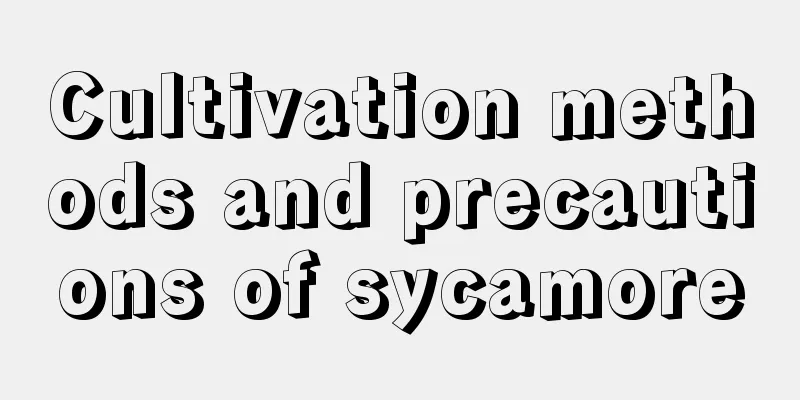Cultivation methods and precautions of sycamore

1. Maintenance methods1. Substrate selection: It is best to choose relatively loose and breathable soil, and the soil layer should be thicker to facilitate the rooting of the sycamore. It can grow in both acidic and neutral soils, but its survival rate is low in alkaline soils, and puddles are also not conducive to the growth of sycamore. 2. Temperature management: Sycamore is suitable for growing in a warm and humid environment. It is afraid of cold and needs insulation treatment when the temperature is below minus 3℃ in winter. Similarly, if the temperature is too high in summer, it will also affect growth. The optimal temperature is roughly 15℃-25℃. 3. Water management: Water the sycamore seedlings frequently in the early stages, and try to keep the soil slightly moist. During the rapid growth stage, increase the amount of water and reduce the number of waterings, and stop watering in the later stage. 4. Nutrient management: Deeply plow the soil around the tree roots every autumn, and add base fertilizers such as oil residue and feces. In addition, during the fruiting period, a mixture of superphosphate, ammonium nitrate and bean cake can be applied. 2. Breeding techniques1. Sowing: Sowing is a common method of propagation. When the sycamore fruits ripen in autumn, pick the bulbs, dry them and take out the seeds. They can be sown in the autumn of the same year, or stored for sowing in the spring of the following year. The recommended row spacing when sowing is 250mm, and then cover with a layer of soil about 15mm thick. 2. Wintering: The weather is very dry in winter, so you need to prune the branches before wintering to prevent water loss. The temperature in the north is low in winter, so you can wrap the tree trunks with a layer of straw mats before winter to keep them warm. 3. Problem diagnosis and treatment1. Frost moth: It feeds on the leaves of sycamore trees, and in severe cases it will eat the entire leaf. Turning the soil several times in winter can kill some insect pupae. After the disease appears, you can spray the back of the leaves with DDT or Lecithin mixed with water. 2. Leaf falling: The plant may be infested with sycamore bugs. You can spray the plant with omethoate once every week. Make sure to use enough medicine and spray evenly. IV. Other issues1. Can it be grown at home? The branches and leaves of the paulownia tree are lush and green, so it can be grown at home. And the management requirements are not strict, so it is very suitable for planting in the courtyard. 2. Can it be planted in the ground: Yes. After growing up, the sycamore is mainly used as an urban greening tree. It requires loose soil, is more water-efficient, and has a higher survival rate when planted in the ground. |
<<: Cultivation methods and precautions of water tower flower
>>: Cultivation methods and precautions of evening primrose
Recommend
How many days does it take for coriander to germinate after being planted?
Coriander is a common condiment with extremely hi...
How to care for wintersweet after it fades
Water in time after the wintersweet flowers fade ...
When should winter melon be planted and harvested?
Winter melon is suitable for planting in a warm a...
How to propagate the saffron vine
The fragrant vine is native to the tropical Ameri...
Six Disease Prevention and Control Methods for Daphne koreana
Daphne koreana stem rot The main affected part of...
Will the Kalanchoe still sprout after being cut bald?
1. Whether it has germinated Kalanchoe can sprout...
How to care for the newly bought Paphiopedilum
1. Prefers semi-shade You should know that wild P...
What is the difference between Rudbeckia and Coneflower?
Flirtatious An obvious difference between Rudbeck...
When to water flowers after repotting (How long to water newly bought flower pots after repotting)
Gardenia potted plants (picture) When spring come...
Where can Eucommia ulmoides be planted?
Eucommia ulmoides planting conditions Eucommia ul...
The difference between Jade Lotus and Thousand Buddha Hands
1. Different plant types The two succulent plants...
Tulip watering precautions, how often to water tulips
1. Watering time Tulips are bulbous plants that p...
It is better to water the golden diamond every few days
How often should I water the golden diamond? Gold...
How to fertilize the big leaf green radish
1. Selection of fertilizer The growth rate of lar...
Ten miles of locust flowers, they are fragrant and sweet when you take a bite, so delicious that you will lick the plate!
Let’s first talk about what locust flowers are ed...









